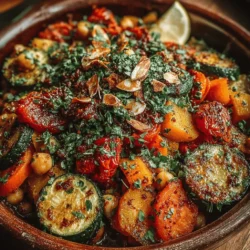Moroccan cuisine is renowned for its vibrant flavors, aromatic spices, and the ability to blend sweet and savory elements seamlessly. One of the most iconic dishes that encapsulates this culinary tradition is the tagine, a slow-cooked stew named after the earthenware pot in which it is traditionally prepared. This Slow-Cooked Moroccan Spiced Vegetable Tagine is not only a delightful exploration of Moroccan flavors but also a wholesome, plant-based meal that offers a host of health benefits. Packed with a variety of vegetables and aromatic spices, this dish is perfect for anyone looking to indulge in a nourishing meal that is both satisfying and full of flavor.
Ingredients
– 2 medium onions, finely chopped
– 4 cloves garlic, minced
– 2 medium carrots, sliced
– 1 medium zucchini, chopped
– 1 red bell pepper, diced
– 1 cup butternut squash, cubed
– 1 can (15 oz) chickpeas, drained and rinsed
– 1/2 cup dried apricots, chopped
– 2 cups vegetable broth
– 2 tablespoons olive oil
– 1 teaspoon ground cumin
– 1 teaspoon ground coriander
– 1 teaspoon ground cinnamon
– 1 teaspoon ground ginger
– 1 teaspoon ground turmeric
– 1/4 teaspoon cayenne pepper (optional)
– Salt and pepper to taste
– Fresh cilantro or parsley for garnish
Instructions
1. Heat olive oil in a large tagine or heavy-bottomed pot over medium heat. Add the chopped onions and minced garlic, sautéing until the onions become translucent and fragrant, about 5-7 minutes.
2. Add the sliced carrots and cook for an additional 5 minutes, stirring occasionally.
3. Stir in the chopped zucchini, diced red bell pepper, and cubed butternut squash. Cook for another 5-7 minutes until the vegetables begin to soften.
4. Add the drained chickpeas and chopped dried apricots to the pot, stirring to combine all ingredients.
5. Sprinkle in the ground cumin, coriander, cinnamon, ginger, turmeric, and cayenne pepper (if using). Stir well to coat the vegetables in the spices.
6. Pour in the vegetable broth, ensuring that all ingredients are submerged. Season with salt and pepper to taste.
7. Cover the tagine or pot with a lid, reduce the heat to low, and let it simmer gently for 45-60 minutes, stirring occasionally, until the vegetables are tender and the flavors are well blended.
8. Once cooked, remove from heat and let it sit for 10 minutes before serving. Garnish with fresh cilantro or parsley.
Exploring the Ingredients of Moroccan Spiced Vegetable Tagine
The foundation of this Moroccan Spiced Vegetable Tagine relies heavily on a blend of fresh vegetables and fragrant spices, each contributing to the dish’s overall depth of flavor and nutritional value.
– Onions and Garlic: These aromatic bases are essential in building the flavor profile of the tagine. They provide sweetness and depth, enhancing the overall dish.
– Vegetables: The choice of vegetables is crucial. Carrots add sweetness and crunch, while zucchini and red bell pepper contribute a fresh, vibrant texture. Butternut squash offers a creamy consistency when cooked, balancing the other ingredients beautifully.
– Chickpeas: As a plant-based protein source, chickpeas not only add substance to the tagine but also a nutty flavor that complements the sweetness of the vegetables and dried fruits.
– Dried Apricots: These fruits introduce a touch of sweetness and chewy texture, contrasting perfectly with the savory elements of the dish.
Analysis of the Spices Used
The spices in this recipe are what truly set this tagine apart, each with its own unique origin and health benefits.
– Ground Cumin: This spice has a warm, earthy flavor and is known for its digestive properties. It’s a staple in Moroccan cooking and enhances the overall aroma of the dish.
– Ground Coriander: With its citrusy notes, coriander lightens the heaviness of the dish while also providing antioxidant benefits.
– Ground Cinnamon: Often associated with sweet dishes, cinnamon adds warmth and depth, creating a comforting flavor profile.
– Ground Ginger and Turmeric: Both spices are celebrated for their anti-inflammatory properties. Ginger adds a zesty kick, while turmeric provides a rich golden color and earthy flavor.
– Cayenne Pepper: Adding a hint of heat, cayenne pepper can be adjusted to taste, allowing for a personalized flavor experience.
– Fresh Herbs: Finally, garnishing the tagine with fresh cilantro or parsley not only brightens the dish visually but also adds a fresh, herbal note that rounds out the flavors beautifully.
Step-by-Step Preparation of the Tagine
To achieve the perfect Slow-Cooked Moroccan Spiced Vegetable Tagine, following precise preparation techniques is essential.
– Preparing the Base: Sautéing onions and garlic is the first step in flavor development. This process releases their natural oils and sweetness, creating a fragrant base for the dish.
– Cooking the Vegetables: Properly adding and cooking the vegetables is key to achieving the right texture. Each vegetable should be added sequentially based on its cooking time to ensure they all reach a tender consistency without becoming mushy.
– Incorporating Spices: Blooming the spices before adding the liquid is crucial for maximizing their flavor. This process allows the spices to release their essential oils, intensifying the overall taste of the tagine.

Combining All Ingredients
Tips for Ensuring Even Distribution in the Slow Cooker
To achieve the best flavor and texture in your Slow-Cooked Moroccan Spiced Vegetable Tagine, it is crucial to evenly distribute all ingredients in the slow cooker. Start by layering the denser vegetables at the bottom, such as carrots and potatoes, which will benefit from the longer cooking time. Place the lighter vegetables like zucchini and bell peppers on top. This method ensures that the heartier ingredients cook thoroughly while the delicate ones remain intact.
Consider seasoning each layer as you go. This technique allows the spices to permeate throughout the dish, enhancing the overall flavor. Stir gently after adding all the ingredients to create an even mixture without mashing the vegetables.
The Slow Cooking Process
Understanding the Science Behind Slow Cooking and Flavor Melding
Slow cooking is an art that relies on low heat over an extended period, allowing flavors to meld beautifully. The gradual cooking process breaks down the fibers in vegetables and legumes, resulting in a tender texture that preserves their natural flavors. As the ingredients cook together, spices release their essential oils, creating a rich, aromatic experience that is fundamental to Moroccan cuisine.
Benefits of Using a Slow Cooker for This Recipe
Utilizing a slow cooker simplifies meal preparation, making it an excellent choice for busy lifestyles. You can set it and forget it, allowing the dish to develop its flavors without constant monitoring. Slow cookers also retain moisture, ensuring that the vegetables do not dry out and remain succulent.
How Slow Cooking Enhances Flavors and Tenderness of Vegetables
The slow cooking process allows for the gradual release of flavors, which meld together to create a harmonious dish. The low temperature also helps maintain the integrity of the vegetables while softening them, resulting in a fulfilling texture that enhances the overall dining experience.
Discussion on Cooking Times: Low vs. High Heat Options and Their Impacts
For the best results, consider cooking your tagine on low heat for 6-8 hours or on high heat for 3-4 hours. The low heat option is typically preferred for developing deeper flavors, while the high heat option is perfect for those who need a quicker meal without compromising too much on taste. Adjusting the cooking time based on your schedule can help you enjoy this delightful dish at your convenience.
Serving and Enjoying Your Tagine
Final Touches: The Importance of Lemon Juice in Brightening Flavors
Just before serving, a splash of fresh lemon juice can significantly elevate the flavors of your tagine. This bright acidity cuts through the richness of the dish and enhances the earthy spices, providing a refreshing balance that is essential in Moroccan cuisine.
Serving Suggestions
Traditional Accompaniments like Couscous and Crusty Bread
To fully appreciate the flavors of your Moroccan Spiced Vegetable Tagine, serve it alongside fluffy couscous or crusty bread. Couscous can soak up the delicious sauce and adds a satisfying texture to every bite. Pairing it with warm, crusty bread allows for delightful dipping and scooping, making the meal more interactive and enjoyable.
Pairing Ideas that Complement the Tagine’s Flavors
For a well-rounded meal, consider pairing your tagine with a light salad dressed in a citrus vinaigrette or a yogurt-based sauce. Additionally, a glass of Moroccan mint tea or a fruity red wine can complement the dish beautifully, enhancing the overall dining experience.
Visual Appeal: Garnishing with Slivered Almonds and Herbs for Presentation
To make your tagine visually appealing, garnish it with slivered almonds and fresh herbs such as cilantro or parsley just before serving. These garnishes not only add texture but also enhance the dish’s presentation, making it a feast for the eyes as well as the palate.
Nutritional Benefits of the Tagine
Overview of the Health Benefits of the Ingredients
The Slow-Cooked Moroccan Spiced Vegetable Tagine is packed with nutritious ingredients that promote a healthy lifestyle. Chickpeas provide a rich source of protein and fiber, while a variety of vegetables contribute essential vitamins and minerals.
Nutritional Value of Chickpeas and Vegetables
Chickpeas are particularly beneficial for heart health and weight management. They are low in fat and high in fiber, helping to keep you full longer. The colorful array of vegetables in the tagine, such as carrots, bell peppers, and zucchini, provide antioxidants and are rich in vitamins A and C, which are crucial for maintaining a healthy immune system.
Antioxidant Properties of Spices Used in the Recipe
The spices in this dish, including cumin, coriander, and cinnamon, possess powerful antioxidant properties that can combat oxidative stress in the body. Incorporating these spices not only enhances flavor but also contributes to overall health.
Discussion on the Balance of Flavors and Nutrition in a Plant-Based Diet
This tagine exemplifies how a plant-based diet can be both flavorful and nutritious. The balance of spices and ingredients creates a satisfying dish that is not only good for you but also delights the senses.
Conclusion
In summary, the Slow-Cooked Moroccan Spiced Vegetable Tagine is a vibrant dish that encapsulates the essence of Moroccan culinary traditions. With its rich flavors and numerous health benefits, it is an ideal choice for those seeking a comforting and satisfying meal. We encourage you to try this recipe, embracing the joy of slow cooking and the pleasure of sharing meals with loved ones. Experience the magic of this tagine, and let it transport you to the heart of Morocco.


